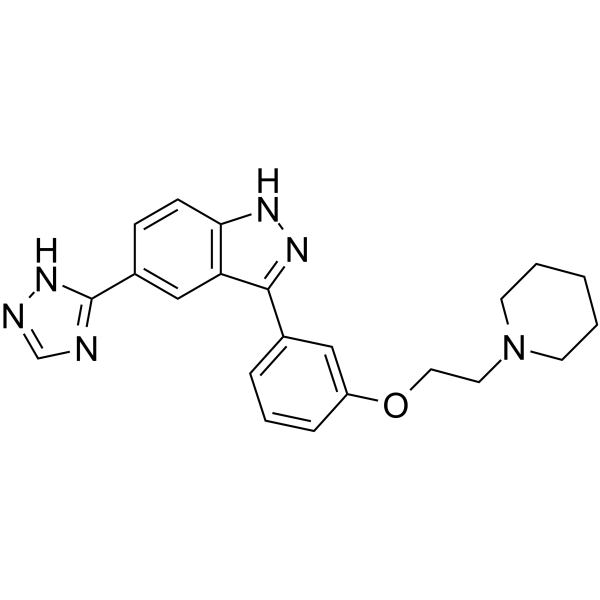上海金畔生物科技有限公司为生命科学和医药研发人员提供生物活性分子抑制剂、激动剂、特异性抑制剂、化合物库、重组蛋白,专注于信号通路和疾病研究领域。
CC-401
CC-401是第二代ATP竞争性JNK抑制剂,具有抗肿瘤活性。

CC-401 Chemical Structure
CAS No. : 395104-30-0
| 规格 | 是否有货 | ||
|---|---|---|---|
| 100 mg | 询价 | ||
| 250 mg | 询价 | ||
| 500 mg | 询价 |
* Please select Quantity before adding items.
CC-401 的其他形式现货产品:
| 生物活性 |
CC-401 is a potent inhibitor of all three forms of JNK with Ki of 25 to 50 nM. |
|
|---|---|---|
| IC50 & Target[1] |
|
|
| 体外研究 (In Vitro) |
CC-401 has at least 40-fold selectivity for JNK compared with other related kinases, including p38, extracellular signal-regulated kinase (ERK), inhibitor of κB kinase (IKK2), protein kinase C, Lck, zeta-associated protein of 70 kDa (ZAP70). In cell-based assays, 1 to 5 μM CC-401 provides specific JNK inhibition. CC-401, a small molecule that is a specific inhibitor of all three JNK isoforms. CC-401 competitively binds the ATP binding site in JNK, resulting in inhibition of the phosphorylation of the N-terminal activation domain of the transcription factor c-Jun. The specificity of this inhibitor is tested in vitro using osmotic stress of the HK-2 human tubular epithelial cell line. CC-401 inhibits sorbitol-induced phosphorylation of c-Jun in a dosage-dependent manner. However, CC-401 does not prevent sorbitol-induced phosphorylation of JNK, p38, or ERK[1]. Shanghai Jinpan Biotech Co Ltd has not independently confirmed the accuracy of these methods. They are for reference only. |
|
| 体内研究 (In Vivo) |
The staining of p-JNK is moderately induced in bevazicumab and Oxaliplatin treatments as compared to control, and in the CC-401-treated samples p-cJun content is significantly lower, consistent with effective JNK inhibition. DNA damage is modestly elevated in combined treatments with CC-401[2]. CC-401 treatment from days 7 to 24 slows the progression of proteinuria, which is significantly reduced compared to the no-treatment and vehicle groups at days 14 and 21. However, there is still an increase in the degree of proteinuria at day 21 in CC-401-treated rats compared to proteinuria at day 5. The vehicle and no-treatment groups developed renal impairment at day 24 as shown by an increase in serum creatinine. This is prevented by CC-401 treatment[3]. Shanghai Jinpan Biotech Co Ltd has not independently confirmed the accuracy of these methods. They are for reference only. |
|
| Clinical Trial |
|
|
| 分子量 |
388.47 |
|
| Formula |
C22H24N6O |
|
| CAS 号 |
395104-30-0 |
|
| 运输条件 |
Room temperature in continental US; may vary elsewhere. |
|
| 储存方式 |
Please store the product under the recommended conditions in the Certificate of Analysis. |
|
| 参考文献 |
|
| Cell Assay [1] |
Human HK-2 proximal tubular epithelial cells are cultured in DMEM/F12 media supplemented with 10% FCS, 10 ng/mL EGF, and 10 μg/mL bovine pituitary extract. For Western blot studies, cells are seeded into six-well plates and allowed to adhere overnight, and medium is changed to DMEM/F12 supplemented with only 0.5% FCS for 24 h, by which time cells are confluent. CC-401 is prepared in citric acid (pH 5.5) and added to the confluent cells 1 h before the addition of 300 mM sorbitol, and cells are harvested 30 min later using urea-RIPA buffer. Three experiments are performed, each with two replicates per condition. For ELISA experiments, HK-2 cells are seeded into 24-well plates, allowed to adhere overnight, cultured in DMEM/F12 with 0.5% FCS for 24 h, and then incubated with CC-401 or vehicle for 60 min before stimulation with 1 μM Angiotensin II (AngII). Supernatants are harvested 48 h later and assayed for TGF-β1 content using a commercial ELISA kit. Three experiments are performed, each using six replicates per condition[1]. Shanghai Jinpan Biotech Co Ltd has not independently confirmed the accuracy of these methods. They are for reference only. |
|---|---|
| Animal Administration [2][3] |
Mice[2] Shanghai Jinpan Biotech Co Ltd has not independently confirmed the accuracy of these methods. They are for reference only. |
| 参考文献 |
|
所有产品仅用作科学研究或药证申报,我们不为任何个人用途提供产品和服务
